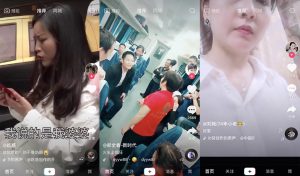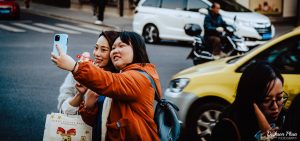
“Meanwhile In China / Yang Mu & Sai Bao – Matthias Schäfer (DE), Sofia Braga (IT)” by Ars Electronica is licensed under CC BY-NC-ND 2.0
Bytedance is now a leading company in China’s internet industry, with high technology. It has several internet products , including the app Douyin, one of the most downloaded apps in the world. This essay will first introduce how the products under the Bytedance company operate and how they generate revenue for Bytedance. It will then analyse the business model of Bytedance to understand how Bytedance has succeeded in the internet industry.
1.introduce to bytedance

1)Advertising
Advertising platforms earn revenue by extracting data from users’ online activities and analysing the data in order to auction off ad space to advertisers. The more users interact with the site, the more information can be collected and used.(Srnicek, 2017). A market research report on ByteDance shows that Douyin app is ByteDance biggest cash flow and the most efficient app for selling ads. Douyin is the fastest growing product in terms of advertising revenue. (Tencent News, 2020))Here are the advertising revenue figures for the Douyin app from 2017 to 2019
Advertising revenue of 15 billion in 2017
2018 advertising revenue 50-55 billion
2019 advertising revenue 100 billion
2) E-commerce
2020 ByteDance’s earnings in the e-commerce segment reach 80 billion yuan. ByteDance expects to develop Douyin into the world’s largest live streaming platform by the end of the year.
3.why do bytedance success
1). A unique artificial intelligence algorithm
Bytedance was founded in China just in time for the peak of internet development. Precise algorithmic analysis allows it to automatically push content of interest to users, saving them the time of selecting content. Take the example of Douyin, whose artificial intelligence algorithms can make intelligent recommendations based on user preferences and app usage, a unique advantage. (Ma, 2021). It can respond to different countries’ regulatory regimes, while outputting content that locals prefer to watch for different countries’ cultures, etc. For example, Asians love to see cute girls and dancing, European and American users love to see something exclusive and exciting, etc. In addition, Douyin’s algorithm allocation is extremely centralised. Bytedance has its own traffic pool. Whether you have followers or not, as long as you post your work you are bound to get plays. After that, Bytedance will then continue to push based on your performance within the traffic pool. Bytedance’s algorithm gives everyone the opportunity to produce content, and the user experience is greatly enhanced.
2). Monetization

Online shopping has taken hold in Asian countries, and in 2018, Bytedance leveraged this with Alibaba, which pioneered live shopping in China. The influence of the platform’s celebrities and stars is used to attract users to buy and drive traffic to the shopping platform. In 2019, Bytedance officially set up its own e-commerce system. Then in April, the Douyin shop was launched, allowing users to spend money directly within Bytedance, without having to jump to an external link.
3)Unique operation model
Douyin has created a new era of short videos. Canadian researchers studied the attention spans of 2,000 people at the turn of the millennium, and did the same experiment 15 years later. In the intervening years – which saw the rapid rollout of home computers, the advent of YouTube and the iPhone, and the rise in availability and fall in cost of affordable home broadband internet – our ability to concentrate on one thing before our brain switched off dropped by a third, from 12 seconds to eight. (Chris,2021).Bytedance has mastered this well, as it captures people’s attention as much as possible by constantly outputting short 15-second videos. With short videos that don’t bore viewers, and a new video swiped every fifteen seconds to release new dopamine in viewers, viewers are never bored.
5.concerns about Bytedance
 “Donald Trump” by Michael Vadon is licensed under CC BY-SA 2.0
“Donald Trump” by Michael Vadon is licensed under CC BY-SA 2.0
On 27 February 2020, Bytedance paid $92 million worth of compensation in the US. (TikTok ban, 2020). The US accused Bytedance of obtaining personal information from users through improper means, including the use of facial recognition technology. And later, former US President Donald Trump banned TikTok, the overseas version of the Bytedance app, from operating in the US. However there is no evidence on the surface that TikTok threatens US national security, and the US ban on TikTok is more politically motivated. It has become commonplace for the US government to step in and suppress overseas companies.
 “The Tik Tok / Douyin Generation” by gunman47 is licensed under CC BY-NC-ND 2.0
“The Tik Tok / Douyin Generation” by gunman47 is licensed under CC BY-NC-ND 2.0
At the same time, the implications of the short-video traffic era have attracted a great deal of scholarly attention in China. Some believe that short videos are corrupting the souls of today’s youth. Most of the content output by Douyin is undernourishing, videos that are only meant to catch the eye. In the long run, this will affect the values of young people. Because of some bad values, ByteDance has been interviewed many times by the state Internet information department. Bytedance next has to keep on strengthening control in content regulation in order to have more good content for short videos.
6.conclusions
As the head company of the Chinese Internet, ByteDance has a large number of breakout products that have driven the development of China’s Internet platforms. While ByteDance is succeeding and becoming increasingly international, it should also reflect on the dangers it is in and how it can better export content to its audience.
Ma, Y., & Hu, Y. (2021). Business Model Innovation and Experimentation in Transforming Economies: ByteDance and TikTok. Management and Organization Review, 17(2), 382–388. https://doi.org/10.1017/mor.2020.69
Srnicek, N., & De Sutter, L. (2017). Platform capitalism . Polity.
Stokel-Walker, C. (2021). TikTok Boom : China’s Dynamite App and the Superpower Race for Social Media. Canbury Press.
ByteDance expert meeting document out: 2020 advertising revenue of 150 billion.(2020).Retrieved from https://new.qq.com/rain/a/20201113A07DFJ00
TikTok ban (Vol. 2020, Issues 9-19). (2020). ABC1 NSW.